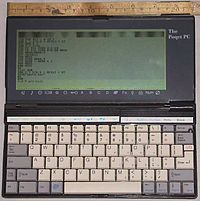Amstrad was a British electronics company, founded in 1968 by Alan Sugar at the age of 21. The name is a contraction of Alan Michael Sugar Trading. It was first listed on the London Stock Exchange in April 1980. During the late 1980s, Amstrad had a substantial share of the PC market in the UK. Amstrad was once a FTSE 100 Index constituent, but since 2007 has been wholly owned by Sky UK. As of 2006, Amstrad's main business was manufacturing Sky UK interactive boxes. In 2010, Sky integrated Amstrad's satellite division as part of Sky so they could make their own set-top boxes in-house.

The Tandy 1000 is the first in a line of IBM PC compatible home computer systems produced by the Tandy Corporation for sale in its Radio Shack and Radio Shack Computer Center chains of stores.

In computing, PC Card is a configuration for computer parallel communication peripheral interface, designed for laptop computers. Originally introduced as PCMCIA, the PC Card standard as well as its successors like CardBus were defined and developed by the Personal Computer Memory Card International Association (PCMCIA).
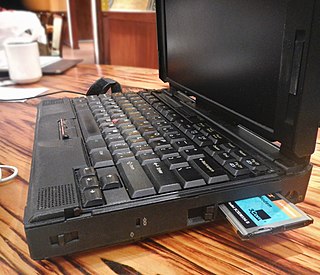
The Personal Computer Memory Card International Association (PCMCIA) was a group of computer hardware manufacturers, operating under that name from 1989 to 2009. Starting with the PCMCIA card in 1990, it created various standards for peripheral interfaces designed for laptop computers.

The IBM PC Convertible is a laptop computer made by IBM, first sold in April 1986. The Convertible was IBM's first laptop-style computer, following the luggable IBM Portable, and introduced the 3½-inch floppy disk format to the IBM product line. Like modern laptops, it featured power management and the ability to run from batteries.

The HandBook was a very small and lightweight subnotebook originally introduced by Gateway 2000 in 1992. It quickly achieved critical acclaim and a cult-like following, especially in Japan.

The Amstrad PC1512 was Amstrad's mostly IBM PC-compatible computer system, first manufactured in 1986. Next year a slight updated version named PC1640 was introduced. It was also marketed as PC6400, and Sinclair PC500. Schneider branded machines for the German market also exists.

The FM Towns Marty is a fifth-generation home video game console released in 1993 by Fujitsu, exclusively for the Japanese market. It is often claimed to be the first 32-bit CD-based home video game system, although it has a 16-bit data bus, just like the earlier Commodore CDTV and Sega CD, which both have Motorola 68000 processors that are similar internally 16/32-bit, but with a 16-bit data bus. The console came complete with a built in CD-ROM drive and disk drive. It was based on the earlier FM Towns computer system Fujitsu had released in 1989. The Marty was backward-compatible with older FM Towns games.
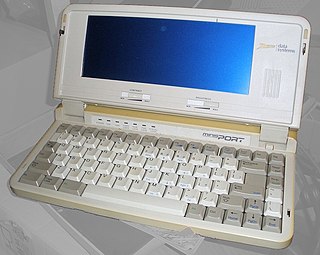
The Zenith MinisPort is a subnotebook based on an 80C88 CMOS CPU running at two software selectable speeds: 4.77 MHz or 8 MHz. It was released in 1989 by Zenith Data Systems (ZDS).

The Atari Portfolio is an IBM PC-compatible palmtop PC, released by Atari Corporation in June 1989. This makes it the world's first palmtop computer.

The TRS-80 Model 100 is a portable computer introduced in April 1983. It is one of the first notebook-style computers, featuring a keyboard and liquid crystal display, in a battery-powered package roughly the size and shape of a notepad or large book.

The HP 200LX Palmtop PC, also known as project Felix, is a personal digital assistant introduced by Hewlett-Packard in August 1994. It was often called a Palmtop PC, and it was notable that it was, with some minor exceptions, a MS-DOS-compatible computer in a palmtop format, complete with a monochrome graphic display, QWERTY keyboard, serial port, and PCMCIA expansion slot.

The Jornada was a line of personal digital assistants or PDAs manufactured by Hewlett-Packard. The Jornada was a broad product line that included Palm-Size PCs, Handheld PCs, and Pocket PCs. The first model was the 820, released in 1998, and the last was the 928 model in 2002 when Compaq and HP merged. The Jornada line was then succeeded by the more popular iPAQ model PDAs. All Jornada models ran Microsoft Operating Systems that were based on Windows CE.

The UltraLite was an IBM PC-compatible laptop released by NEC in October 1988. It was released alongside the heavier and more-capable ProSpeed. The UltraLite was based on the NEC V30 microprocessor; the computer includes MS-DOS 3.3 built into ROM.

The HP 95LX Palmtop PC, also known as project Jaguar, was Hewlett Packard's first MS-DOS-based pocket computer, or personal digital assistant, introduced in April 1991 in collaboration with Lotus Development Corporation. It can be seen as successor to a series of larger portable PCs like the HP 110 and HP 110 Plus.

The Contura was a line of notebook computers produced by Compaq. Released in 1992, the Contura was Compaq's first attempt at making an affordable, entry-level laptop computer.
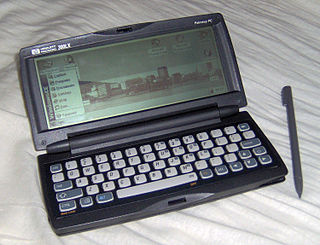
The HP 300LX was one of the first handheld PCs designed to run the Windows CE 1.0 operating system from Microsoft. Unlike other HPCs of the time, the resistive touch screen had an enhanced screen resolution of 640x240 with 4 shades of grey, rather than the standard 480x240 resolution of other devices, such as the Casio Cassiopeia A-10. The device also sported a full PC card slot, a serial link cable plug, and an infrared port.
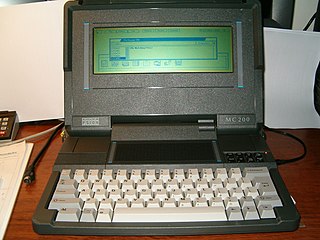
The Psion MC series is a line of laptop computers made by Psion PLC and launched in 1989.
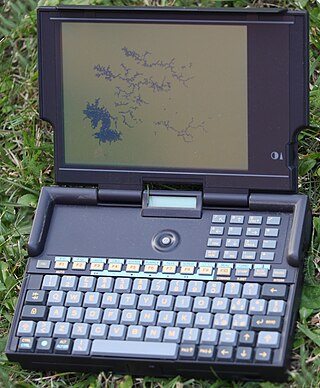
The Quaderno was a subnotebook produced by Olivetti in two versions from 1992: Quaderno (PT-XT-20) and Quaderno 33 (PT-AT-60).
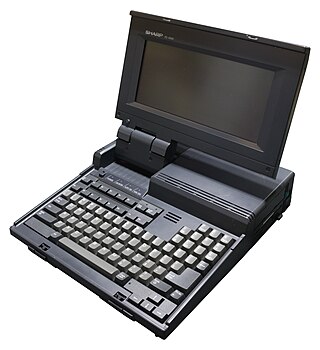
The Sharp PC-4500 is a line of laptop computers released by Sharp Corporation in 1987. The line comprises the PC-4501, the PC-4502, and the PC-4521. The PC-4501 is a bare-bones unit with only 256 KB of RAM stock, only one floppy drive, no backlighting, and no built-in numeric keypad; the PC-4502 and PC-4521 bumps the stock RAM to 640 KB and includes the latter two features while providing either two floppy drive (PC-4502) or one floppy drive and a 20 MB hard drive (PC-4521). Prices on the line initially ranged from $1,295 to just under $3,000; the PC-4501 was later sold for $995, becoming one of the first sub-$1,000 laptops available on the market. The PC-4500 line received mixed, mostly positive, reviews on its release in September 1987.
